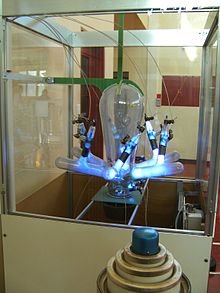
Back صمام القوس الزئبقي Arabic Rtuťový usměrňovač Czech Quecksilberdampfgleichrichter German Elavhõbealaldi Estonian Elohopeatasasuuntaaja Finnish Diode à vapeur de mercure French Raddrizzatore al mercurio Italian 水銀整流器 Japanese Kwikdampgelijkrichter Dutch Ртутный выпрямитель Russian

A mercury-arc valve or mercury-vapor rectifier or (UK) mercury-arc rectifier[1][2] is a type of electrical rectifier used for converting high-voltage or high-current alternating current (AC) into direct current (DC). It is a type of cold cathode gas-filled tube, but is unusual in that the cathode, instead of being solid, is made from a pool of liquid mercury and is therefore self-restoring. As a result mercury-arc valves, when used as intended, are far more robust and durable and can carry much higher currents than most other types of gas discharge tube. Some examples have been in continuous service, rectifying 50-ampere currents, for decades.
Invented in 1902 by Peter Cooper Hewitt, mercury-arc rectifiers were used to provide power for industrial motors, electric railways, streetcars, and electric locomotives, as well as for radio transmitters and for high-voltage direct current (HVDC) power transmission. They were the primary method of high power rectification before the advent of semiconductor rectifiers, such as diodes, thyristors and gate turn-off thyristors (GTOs) in the 1970s. These solid state rectifiers have almost completely replaced mercury-arc rectifiers thanks to their higher reliability, lower cost and maintenance and lower environmental risk.[3]
- ^ Electrical Year Book 1937, Emmott and Company, Manchester, England, pp 180-185
- ^ Rissik, H., Mercury-Arc Current Converters, Pitman. 1941.
- ^ "History | IEEE Power & Energy Magazine". magazine.ieee-pes.org. Retrieved 17 January 2017.
© MMXXIII Rich X Search. We shall prevail. All rights reserved. Rich X Search